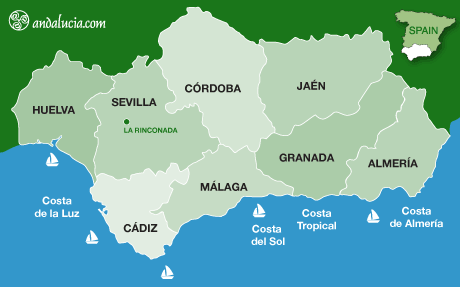LA RINCONADA
by Saskia Mier
La Rinconada has one of the biggest rose farms in the world and it is worth visiting its casco antiguo (old town), with its cobbled, winding streets and beautiful houses whose facades are decorated with flowers. It has about 38, 200 inhabitants.
HISTORY
The first human settlements date from the eighth century A.C. in the so-called "Cerro Macareno", located at the base of the River Guadalquivir, and constitutes an extensive archaeological site of more than 50,000m².
In 1594, La Rinconada was part of the Kingdom of Seville in the Axarafe (Aljarafe) and the first woman who lived there was called, 'Carmen La Suspira'.
Originally, La Rinconada served to defend and warn from attacks of the city. It was governed by Mayors who needed the approval of Seville to be able to rule until the eighteenth century in which the new dynasty came from France. The Bourbons brought a more modern mentality on how to defend the territory.
Since La Rinconada never belonged to any Count, Duke, Marquis or Monastery, it was never a Lordship, but realengo, a free settlement due to its dependency directly on the King.
Hotels
Book hotels in La Rinconada
THINGS TO SEE
Iglesia de Nuestra Señora de las Nieves
Mudéjar church built in the fifteenth century and the tower is of the eighteenth century. Located in Plaza de España.
Casa Consistorial
The Casa Consistorial was raised by the construction boom of the Ibero-American Exhibition of Seville in 1929 and signed by the architect, Aníbal González. It was raised in the years in which there was strong influence of the exhibition and clear characteristics of the architecture during that era. It is currently the Town Hall. Located in Plaza de España.
Museo Arqueológico y Paleontológico 'Francisco Sousa'
The collection of pieces in the Archaeological and Paleontological Museum began in 1982 with the help of Francisco Sousa. In 1986 the first exhibition of the pieces was held in the Instituto 'Miguel de Mañara'. In 1997 it passed into the hands of the Town Hall who moved all the pieces to the Casa Cultura (Cultural Centre). A great variety of fossils of all geologic eras have been discovered as well as the remains of Elephas Antiquus (a pre-historic elephant) that inhabited the area 100,000 years ago. Every year, around November, the University of Seville and UNED celebrate a seminar in La Rinconada on the latest advances discovered in palaeontology and archaeology. This event has been established in the calendar of seminars in Seville and Western Andalusia, each year welcoming more than 200 participants. Located on Calle Vereda de Chapatales.
For visits to the museum, one must contact the Casa de Cultura (Cultural Centre).
Tel: 955 794 142
Email: [email protected]
Capilla de los Dolores
The chapel is home to the Brotherhood, Real y Primitiva Hermandad de la Misericordia de Nuestro Señor Jesucristo y Fervorosa dating to the year 1954. Located on Calle Maestro Morillo.
Parroquia de San José
The chapel is located on Calle Cristo del Perdón.
Iglesia de Santa María
The church is located in Plaza Juan Ramón Jiménez.
THINGS TO SEE OUTSIDE THE VILLAGE
Cerro Macareno
The archaeological site consists of archaeological remains of some civilizations on top of others. The abundance of amphora fragments that have been found served mainly as containers to transport products such as wheat, oil and wine, therefore confirming the commercial importance that Cerro Macareno had as a river port. Pieces can be seen in the Archaeological and Paleontological Museum. Located on the Carretera Sevilla-San José de La Rinconada, A-8001.
NATURAL AREAS
La Rinconada has recovered the natural heritage of the area consisting of Parque de El Majuelo, Parque de Las Graveras, Eje del Agua, Parque '8 de Marzo', Parque Quintero, León y Quiroga, Parque Dehesa Boyal, Entorno El Malecón, Entorno Centro de Salud, Plaza de Los Inventores, Valle Inclán, Parque de Los Pintores, Parque Félix Rodríguez de la Fuente, Parque de la Comunidad Económica Europea, Parque 1 de Mayo, Miguel de Mañara and Parque Central de La Unión.
GASTRONOMY
Typical dishes to try when in La Rinconada are potaje de chícharros (fish stew), caracoles (snails) and garbanzos con espinacas (spinach with chickpeas).
HANDICRAFTS
The most important craft of La Rinconada is waxwork, although goldsmithing is also traditional.
FESTIVALS
Cabalgata Reyes Magos Three Kings procession celebrated on the evening of 5 January.
Carnaval Celebrated in February.
Fiestas en Honor a San José Celebrated the 19 March.
Semana Santa Holy Week.
Fiestas en honor a la Virgen de la Salud Celebrated in May.
Cruces de Mayo Celebrated in May.
Feria de Junio"La Jira" Celebrated the first weekend of June.
Feria de Julio Celebrated the first week of July.
Fiestas Patronales y Velá de Los Dolores Celebrated in September.
NEXT PLACES
The next villages to La Rinconada are Alcalá del Río, La Algaba and Seville City.
Book your stay in Andalucia Now!
